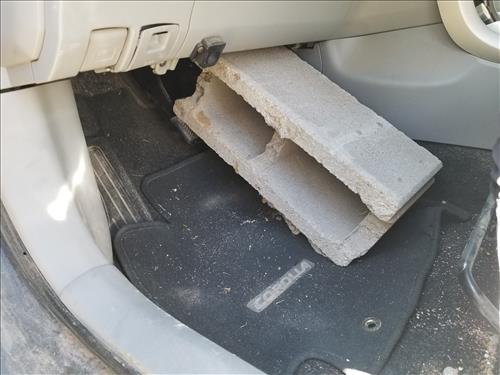
If you find yourself alone after changing out brake pads or a master cylinder and have no help to bleed them, there are a few ways to do it alone.
This happens to many DIY mechanics as most people disappear when it’s time to go to work. Luckily there are some easy options.
Can You Bleed Brakes By Yourself?
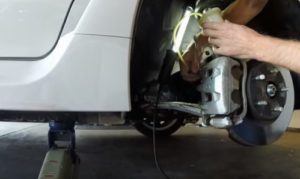
Yes, one person can bleed the brake lines on a vehicle using one of several different methods.
Common methods include one-man brake bleeder kits, vacuum pump brake bleeder kits, cinder block method, and gravity bleeding.
Which method is best will depend on the person as all will work to get the air out of the brake lines.
Here are some of the options I have used over the years. As always, be sure to call a certified professional if in doubt.
4 Ways To Bleed Brake Lines By Yourself
- One Man Brake Bleeder Kit
- Use a Vacuum Pump Kit
- Use a Cinder Block
- Gravity Bleeding the Brake Lines
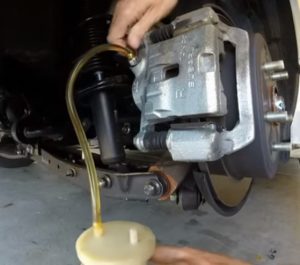
One-man bleeder kits are cheap to buy, or can one can be made up at home with a few items.
Basically, a tube goes from the bleeder screw into a holding container with brake fluid and is submerged.
After it is hooked up and the bleeder screw opened, the pedal can be pressed, and air bubbles will escape. When the pedal is let up, since the tube is submerged in the fluid, only fluid will go back in.
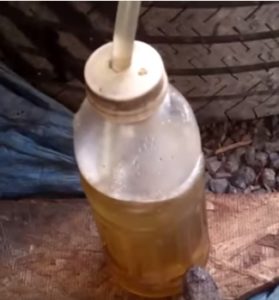
If you have a tube, preferably a clear one, that fits tightly on a bleeder screw, then an old jar can be used as a holder for fluid and the tube to submerge in.
Kits are cheap to buy, usually less than $10 dollars as there is not much to them.
*This site contains affiliate links for which a commission is earned.
Example DIY brake bleeder kit on Amazon
Available Here on Amazon
This is a good option, and one I like to use as a kit is very cheap, and they are simple to use.
The small kits can be stored away and used again when needed without needing any help.
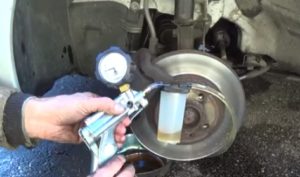
There are many low-cost vacuum pump kits that let you bleed your lines quickly on your own.
They hook to the bleeder screw and, with some pumping action, create a vacuum that pulls out fluid and air bubbles quickly.
This is a nice method and possibly the fastest DIY option.
The kits are low cost and good for those DIY mechanics who do brakes more often than every few years.
Example Vacuum Pump Brake Bleeder Kit on Amazon
Available Here on Amazon
This is a good option, and one I like to use as a kit is very cheap, and they are simple to use.
The small kits can be stored away and used again when needed without needing any help.
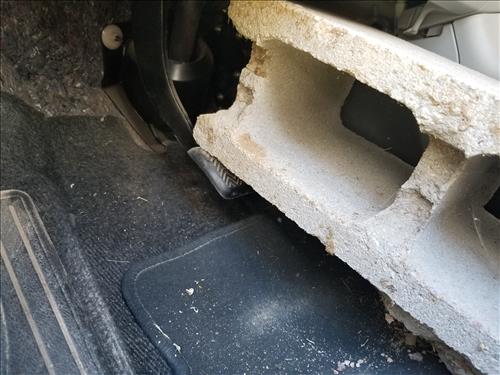
Using a heavy object, such as a cinder block, the pedal can be pumped on and held by the weight of the brick.
This is not ideal but does work and requires multiple trips into the vehicle to pump the brakes.
It works the same as a helper, except every time the bleeder valve is opened, you will need to go and pump the brakes again and lean the brick against the pedal to hold it.
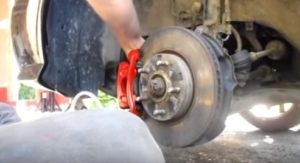
I have to admit, after working on cars my whole life and many DIY brake jobs, I had never heard of this option until a few years ago.
A friend of mine showed me this method, and it does work, although it is not the best way to get the job done.
One thing to note about this method is it takes a lot of time but does work with no help necessary and no cost for extra tools.
To gravity bleed, the master cylinder cap is removed, and the brake bleeder screw loosened.
Gravity will slowly push out fluid and air bubbles in the line, slowly self bleeding them.
Be sure to keep an eye on the fluid level in the master cylinder as it can not go empty.
A puddle of fluid will slowly show up under the brake. After some time, close the bleeder screw and move on to the next wheel in the line.
Again this takes time to do, and each wheel can take an hour or so to get results. Most of us don’t have this kind of time to waste, but it will work in a pinch.
How Do You Bleed Brakes by Yourself Without a Machine?
The two main methods to bleed brakes without a machine are to use the gravity feed method and the cinder block method.
The cinder block method is the most used method, which uses a heavy cinder block to hold the brake pedal down.
A block or heavy item holds the brake down while the bleeder valve is released.
Likewise, gravity bleeding brakes can also be done but requires more time to finish the job.
Gravity bleeding the air out of the brakes opens the bleeder valve and lets gravity remove the air bubbles slowly over a few hours.
Summary
Bleeding a vehicles braked yourself can be done with the right tools.
As with anything, there is always more than one way to get things done, and the above methods are simply the best ones I have found over the years.
If you have a good way to bleed the brakes by yourself with no help, let me know in the comments.
With any above methods, remember to always check the master cylinder reservoir for fluid level and keep it full, since if it goes empty, the process must be started all over again.
Also, be sure to test the brakes are working well before moving the vehicle; if the pedal is soft, start over until it feels right.
It is also a good idea to leave the cap off the master cylinder, so a vacuum isn’t created between the lid and the fluid.
Most vehicle brake bleeding starts with the farthest brake from the master cylinder then moves forward to the closest. Of course, always follow the manufacturing guidelines.
As always, be sure to call a professional if there is ever any doubt about doing the job yourself.
You can also purchase what they call speed bleeders. They are the bleeder screw themselves but with a check valve in them. As you depress the pedal it allows the fluid thru releasing the pressure closes the check valve.
I am going to replace a rear line on my 96 GMC half ton. I am going to use the vacuum method, but I will use an outboard primer bulb to suck the fluid through the line. I can pick one up at Canadian Tire for $10.00.
It is also handy for lawn mower or other small engine oil changes.
Hi Bill,
Have you tried bleeding the brake system with the primer bulb yet? I’ve been toying with the idea myself and your comment is the first mention on the internet i’ve found of using a primer bulb. The alternative choice of a hand operated vacuum pump seems to produce variable results.
I would appreciate to know if you were sucessful and any tips you might have.
Regards, Tim.
A method I’ve always used is to pump the brakes the usual three times, hold the pedal down with a cinder block, then loosen the bleeder. Rinse and repeat until you get a steady stream… It takes a while and is a bit tedious with all of the getting up and going back, but it works like a charm when you don’t have any help.
Ditto, I have used this method many times over the years. Its a pain but works.
I replaced the rear caliper and hose on my 2014 traverse and cannot get any pedal I started with the wife operating the brake pedal and me bleeding, didn’t work. Purchased a bleeder kit from Harbor Freight have sucked at least a pint of fluid through still no brake, don’t know what to do since the fluid comes through good. I wouldn’t think the air could get to the other wheels but I even tried sucking fluid through them but to no avail, rather stuck and don’t know what is next may try the gravity flow next. Couple years ago I put all new brake lines on my 96 Dodge truck and did it by myself using a stick on the pedal, have used this method several times. Bill Dotson Thanks for the help.
The submerged tube in a jar with fluid is about the only way to bleed an old Harley! and end up with a good break!
I need help, I replaced brakes and caliper and got air in the line. I have tried gravity bleeding, and both one man options, still can’t get anything to come out the bleeder screw. I checked to make sure no issues with the lines, but there is fluid coming thru at the brake line in the back of the caliper, it’s just not filling the caliper. Any suggestions? I have been working on brakes for years and never had this much trouble?
Is the bleeder valve plugged somehow? Or maybe not drilled all the way through?
Yes if getting fluid to caliper then not filling up try getting someone to pump brakes for you to it fills up or started to get pedal .may sometimes have to bleed line at master cylinder
There is a right side and a left side caliper , You will never get the air out ever! they must be on the right side. just remember, the bleeder is always on top of the caliper. good luck….. Johnny
Have been a mechanic since I did my own work back in the 60’s before I started working at the local Chevrolet Dealership, worked for other dealerships plus independent repair shop and I have never ran into this, this a new one on me and we did a lot of brakes and bled a lot, hoping to get figured out soon since the wife is wanting her wheels, Thanks again.
some of the above method does not work if you’d drained the whole system. you have to close the bleeder value when brake foot is to floor to “pump fluid toward the brakes”. (if left open, it will merely suck air back in, and your system is still full of air. the pedal is clearly bi-directional pushes and pulls fluid)
for this reason you need two people OR suction at bleeder screw OR on the master cylinder if your system is completely dry (to be practical and quick – perhaps if you resevoir all for and wait for days …)
For Brake Bleed: older mechanics say sucking at the Master Cylinder is superior and allot easier than all that per wheel fooling around: but the tool for it is harder and harder to find due to non-standard china plastic custom brake fluid resevoirs. obviously this doesn’t do a brake FLUSH (to get new fluid in the caliper area – the only way is the bleeder valve – due to cost efficient but inconvenient design))
Obviously, dime stores are pushign these $12 8oz empty bottles and are pushing the “do every wheel” for bleeding. Again: for flushing that’s good, but for bleeding it’s totally fooling around.